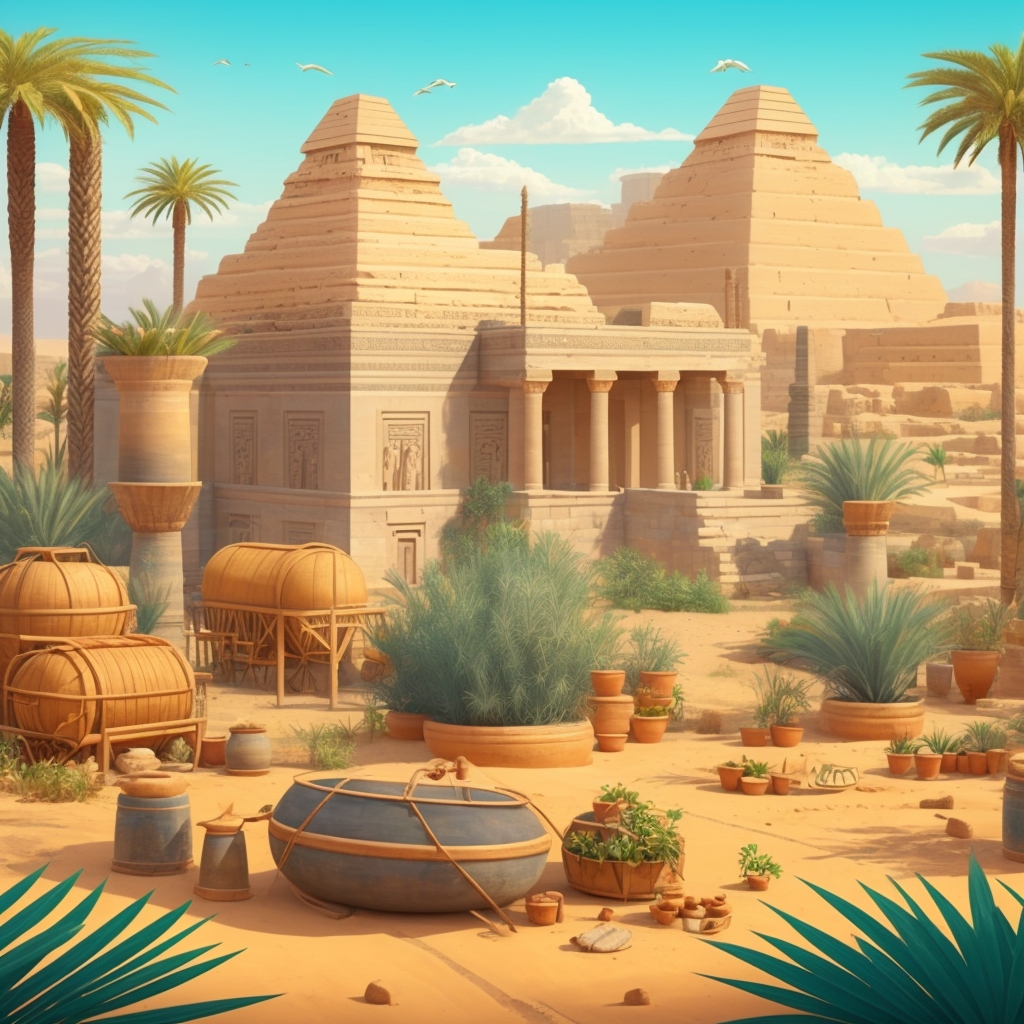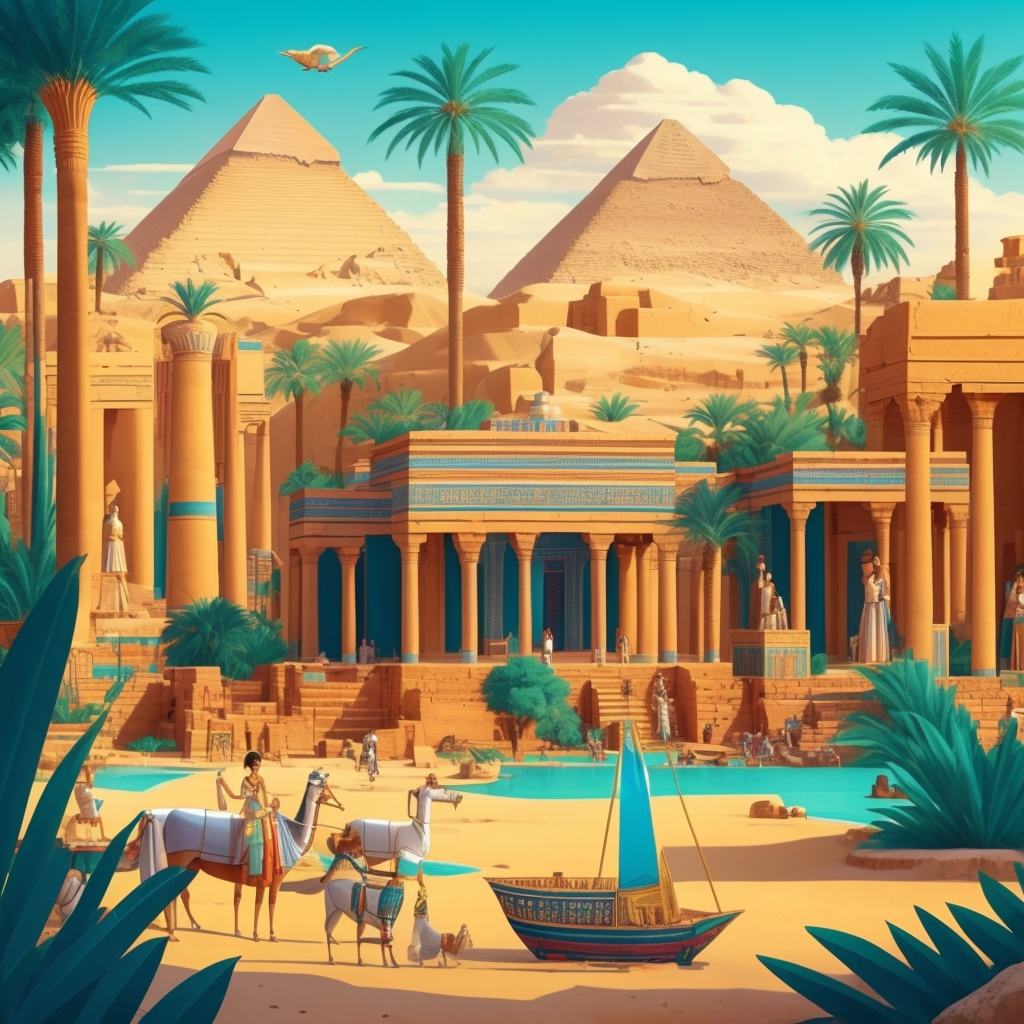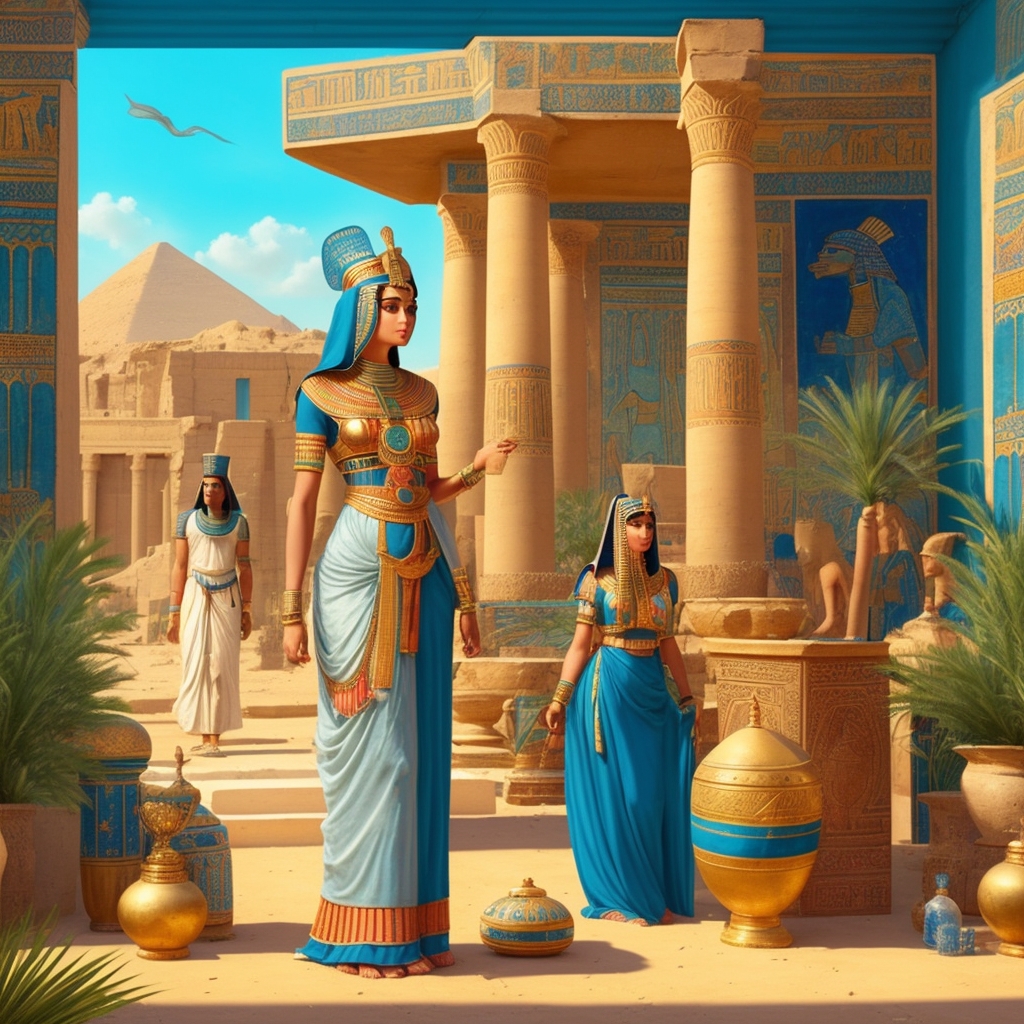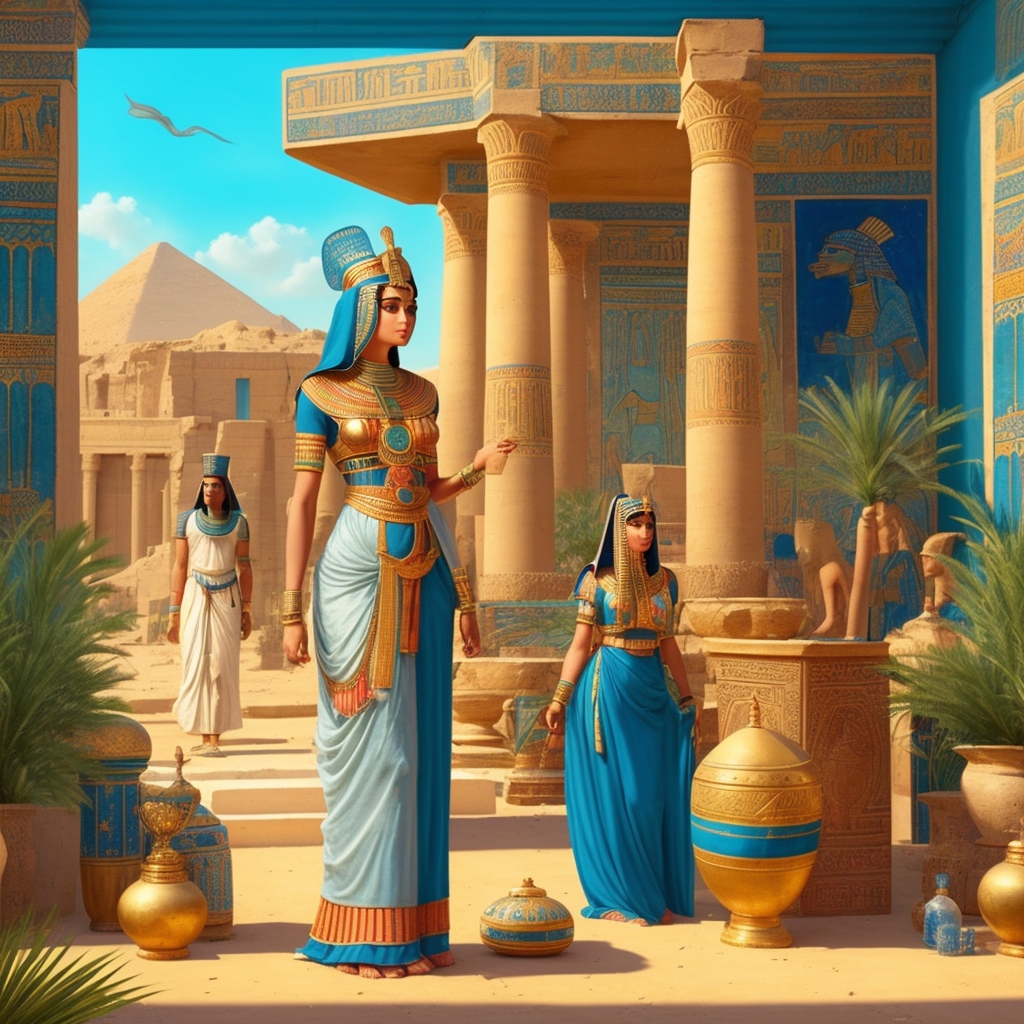Ancient Egypt’s Revolutionary Agricultural Techniques: Engineering Prosperity in the Desert
Ancient Egypt, often called the “gift of the Nile,” is renowned for its advanced civilization that thrived for millennia. But here’s the truly fascinating question: how did this society manage to not just survive, but flourish for thousands of years in such a seemingly harsh desert environment? The answer, quite compellingly, lies largely in its ingenious agricultural techniques that allowed the Egyptians to truly harness the Nile’s incredible, life-giving resources. This article delves into these brilliant methods and explores how they underpinned Egypt’s enduring prosperity and remarkable long-term sustainability.
What makes this story even more remarkable is that these ancient innovations continue to influence modern agricultural practices and water management systems worldwide. From the terraced fields of Southeast Asia to contemporary precision irrigation systems, the fundamental principles pioneered by Egyptian farmers over 5,000 years ago remain surprisingly relevant in our current era of climate change and food security challenges.
Mastering the Waters: Ingenious Management Techniques
Basin Irrigation: A Timeless Solution
One of the most significant and truly foundational techniques was basin irrigation. What’s interesting is how elegantly simple yet profoundly effective this method was, relying entirely on the natural flooding cycle of the Nile to irrigate farmland. Egyptians weren’t just passively waiting for the flood; they actively engineered canals and basins to channel and contain the precious water in their fields. During the annual flood season, typically occurring between July and October, water would be purposefully retained in these earthen basins, allowing it to slowly seep into the soil, thoroughly saturating it and, crucially, enriching it with a fresh layer of nutrient-rich silt.
This process, remarkably, naturally replenished soil fertility year after year for millennia – a concept we’re still striving to perfect in modern regenerative agriculture practices. The silt deposited during these floods contained essential nutrients like nitrogen, phosphorus, and potassium, creating what agricultural scientists today would recognize as a perfect natural fertilizer system. Modern soil analysis of ancient Egyptian farmland reveals nutrient profiles that many contemporary farmers would envy, demonstrating the extraordinary effectiveness of this time-tested approach.
The engineering precision required for basin irrigation was truly astounding. Egyptian farmers had to calculate the exact height of basin walls to capture optimal water levels without causing destructive flooding. They developed sophisticated measuring systems, including nilometers – ancient instruments that tracked water levels with remarkable accuracy. These measurements weren’t just technical exercises; they formed the basis for tax assessments, crop planning, and even religious ceremonies celebrating the life-giving floods.
Dikes and Canal Systems: The Arteries of Prosperity
Beyond individual basins, the Egyptians developed a complex and extensive network of dikes and canals to distribute water with astonishing efficiency across vast stretches of land. These structures weren’t merely ditches; they were sophisticated controls, meticulously designed to manage the flow of water to various regions, maximizing resource use and significantly expanding cultivable land. Archaeological evidence suggests that some of these canal systems stretched for hundreds of kilometers, creating an interconnected hydraulic network that would impress modern engineers.
This sophisticated water management, in my view, was absolutely critical. It ensured a consistent and reliable food production, which was essential to support a growing population and, indeed, the very foundation of their highly centralized economy. The canal systems featured ingenious elements like sluice gates made from stone and wood, allowing farmers to precisely control water flow to different fields based on crop needs and seasonal requirements.
It’s a testament to their foresight that such complex hydraulic engineering was mastered thousands of years ago, a challenge many developing nations still grapple with today. Recent archaeological discoveries using ground-penetrating radar have revealed previously unknown canal networks, suggesting that the scope of Egyptian water management was even more extensive than previously imagined. These findings continue to inform modern irrigation projects in arid regions worldwide, proving that ancient wisdom often surpasses contemporary solutions.
Cultivating Success: Smart Farming Practices
Crop Rotation: Nature’s Fertilizer
Crop rotation was a widely practiced and incredibly smart technique used to maintain soil fertility. Instead of depleting the land with monoculture, Egyptians wisely alternated staple crops like wheat and barley with other plants, which intuitively helped replenish soil nutrients. This proactive approach to soil health prevented widespread land degradation, a problem that, frustratingly, plagues many agricultural systems even today in 2024.
The Egyptian rotation system was remarkably sophisticated, often following a three-year cycle that included cereal grains, legumes like lentils and chickpeas, and periods of managed fallow. Leguminous crops naturally fixed nitrogen in the soil through their root systems, while fallow periods allowed natural vegetation to restore organic matter and prevent pest buildup. This biological understanding, achieved through millennia of careful observation, mirrors principles that modern agricultural science has only recently begun to fully appreciate.
Contemporary research in sustainable agriculture has validated many Egyptian practices, showing that their rotation systems maintained soil organic matter levels that many modern farms struggle to achieve even with synthetic fertilizers. It’s a simple concept, but its long-term impact was monumental, supporting continuous cultivation for over three millennia without significant soil degradation.
Cultivation of Adapted Crops: Playing to Strengths
They also demonstrated remarkable foresight by selecting crops perfectly suited to the local climate and the Nile’s unique, silt-rich soils. Wheat and barley were, unsurprisingly, the primary staple crops that thrived in these conditions, but the Egyptians also cultivated an impressive diversity of other plants including emmer wheat, flax, onions, garlic, leeks, lettuce, cucumbers, and various fruits like figs, dates, and grapes.
This strategic choice ensured reliable and abundant harvests, forming the backbone of their diet and economy. The Egyptians developed numerous varieties of each crop, selecting for traits like drought tolerance, disease resistance, and optimal nutritional content. Archaeological evidence from ancient granaries shows that they maintained seed banks, preserving genetic diversity that allowed them to adapt to changing environmental conditions over centuries.
It’s a classic example of working with nature, not against it – a lesson that remains incredibly pertinent for sustainable farming initiatives globally. Modern plant breeders studying ancient Egyptian crop varieties have discovered genetic traits that could prove valuable for developing climate-resilient crops for the 21st century, demonstrating how ancient agricultural wisdom continues to offer solutions for contemporary challenges.
Advanced Techniques: Beyond the Basics
Shaduf Technology: Mechanical Innovation
The Egyptians also pioneered the use of the shaduf, a counterweighted lever system that revolutionized water lifting and irrigation efficiency. This ingenious device, consisting of a long pole balanced on a fulcrum with a weight on one end and a bucket on the other, allowed farmers to lift water from canals to higher fields with minimal physical effort. The shaduf represented one of humanity’s earliest mechanical innovations in agriculture, demonstrating Egyptian ingenuity in solving practical farming challenges.
Archaeological evidence suggests that shadufs were widely used throughout Egypt by 1500 BCE, and remarkably, similar devices are still employed in rural areas of Egypt and other parts of Africa and Asia today. This longevity speaks to the fundamental soundness of the design and its practical effectiveness in small-scale irrigation systems.
Seasonal Timing and Agricultural Calendars
Egyptian farmers developed sophisticated understanding of seasonal timing, creating detailed agricultural calendars that coordinated farming activities with the Nile’s flood cycle and astronomical observations. They divided their agricultural year into three distinct seasons: Akhet (flooding), Peret (growing), and Shemu (harvesting), each requiring specific farming activities and techniques.
This systematic approach to agricultural timing was crucial for maximizing yields and ensuring food security. Farmers knew precisely when to prepare fields, plant seeds, and harvest crops based on centuries of accumulated knowledge passed down through generations. The integration of astronomical observations with practical farming created a remarkably reliable system that sustained Egyptian civilization through various climatic fluctuations and political changes.
Real-World Impact: How It All Came Together
A truly compelling example of these techniques in action is the sheer expansion of cultivated land under Pharaoh Seti I (1294-1279 BCE). Ambitious canal construction projects during his reign significantly increased arable land, transforming Egypt into a major grain exporter in the ancient world. Historical records indicate that these projects involved coordinating thousands of workers and required sophisticated project management skills that wouldn’t be out of place in modern large-scale infrastructure development.
Imagine the administrative and engineering prowess required for such a feat without modern machinery! It’s mind-boggling to consider the scale of human coordination involved. The projects required precise surveying to ensure proper water flow gradients, massive earthmoving operations using only hand tools and human labor, and ongoing maintenance systems to keep the canals functioning effectively. The success of these endeavors demonstrates not only technical skill but also remarkable organizational capabilities that enabled Egypt to maintain its agricultural supremacy for centuries.
Another powerful illustration is the meticulous agricultural management around the bustling city of Memphis. Here, Egyptian engineers designed intricate canal systems that precisely diverted Nile water to nearby fields, effectively turning the region into a vital grain hub for the entire country. The Memphis agricultural zone became so productive that it could support not only the city’s large population but also generate substantial surpluses for trade and storage.
This wasn’t just about feeding a city; it was about fueling an empire, showcasing an early form of strategic food security planning. The Memphis system included sophisticated storage facilities, quality control measures for grain, and distribution networks that supplied food throughout the kingdom. Archaeological excavations have revealed granaries capable of storing thousands of tons of grain, complete with ventilation systems and pest control measures that kept stored food fresh for extended periods.
The success of these regional agricultural centers enabled Egypt to weather periodic droughts and political instabilities that might have devastated less well-organized societies. This resilience, built on agricultural innovation and careful resource management, helps explain Egypt’s remarkable longevity as a unified civilization.
Environmental Adaptation and Sustainability
Climate Resilience Through Diversity
Egyptian agricultural success wasn’t just about maximizing production; it was about creating resilient systems that could adapt to environmental variations. The Nile’s flood levels varied significantly from year to year, and Egyptian farmers developed strategies to cope with both exceptionally high and low floods. During high flood years, they constructed temporary channels to prevent destructive flooding, while in low flood years, they maximized water conservation through careful basin management.
This adaptive approach included maintaining diverse crop portfolios that could perform well under different conditions. Some varieties were selected for their ability to thrive with minimal water, while others were optimized for high-flood years when abundant moisture was available. This agricultural biodiversity provided insurance against crop failures and ensured consistent food production despite environmental uncertainties.
Soil Conservation and Long-term Thinking
Perhaps most remarkably, Egyptian agricultural practices demonstrated extraordinary long-term thinking about soil conservation and environmental stewardship. Unlike many agricultural systems that prioritize short-term yields at the expense of soil health, Egyptian methods actually improved soil quality over time through the systematic addition of nutrient-rich silt and organic matter.
Modern soil scientists studying ancient Egyptian farmland have found evidence of sustained soil fertility that lasted for millennia, a stark contrast to contemporary agricultural areas where intensive farming has led to significant soil degradation within decades. This difference highlights the importance of working with natural processes rather than against them, a principle that sustainable agriculture advocates are working to reintroduce in modern farming systems.
Key Takeaways: Enduring Lessons from the Nile
-
Optimal use of natural resources: The Egyptians masterfully leveraged the Nile’s predictable flood cycle for sustainable irrigation, achieving incredible results without complex modern technologies. They truly understood their environment and worked in harmony with natural cycles rather than attempting to dominate them.
-
Innovative water management: Their dikes and canal systems weren’t just infrastructure; they were a testament to precise water distribution, enabling vast agricultural capacity and showcasing engineering brilliance. These systems demonstrated remarkable efficiency in water use, achieving maximum agricultural output with minimal waste.
-
Strategic crop selection: Adapting crops to their specific environment ensured remarkably stable and consistent food production for millennia. It highlights the importance of biodiversity and local adaptation in creating resilient agricultural systems that can withstand environmental challenges.
-
Sustainable agricultural practices: Through methods like crop rotation and natural soil enrichment, they preserved land fertility over centuries, a lesson in long-term thinking that remains profoundly relevant in 2024-2025 discussions about regenerative agriculture and food security.
-
Integration of technology and tradition: Egyptian farmers successfully combined mechanical innovations like the shaduf with traditional knowledge about seasonal timing and crop management, creating comprehensive agricultural systems that maximized both efficiency and sustainability.
-
Community coordination and knowledge sharing: The success of Egyptian agriculture depended on sophisticated social systems that coordinated labor, shared knowledge across generations, and maintained the complex infrastructure required for large-scale irrigation and farming operations.
Frequently Asked Questions
Why was the Nile so incredibly important for Egyptian agriculture?
Simply put, the Nile was Egypt’s lifeblood. It provided the only reliable water source in a vast desert, and its annual floods deposited incredibly fertile silt, making abundant harvests not just possible, but predictable. Without the Nile, ancient Egypt as we know it simply wouldn’t have existed. The river’s predictable flooding cycle allowed Egyptians to develop sophisticated agricultural calendars and plan their farming activities with remarkable precision, creating the foundation for one of history’s most stable and prosperous civilizations.
What were the main crops grown in Ancient Egypt?
Wheat and barley were the undeniable primary staples, used for bread and beer, which were fundamental to their diet. Beyond these, Egyptians also cultivated a variety of vegetables, fruits (like figs and dates), and flax, which was crucial for producing textiles. Other important crops included emmer wheat, lentils, chickpeas, onions, garlic, leeks, lettuce, cucumbers, and various herbs and spices. This agricultural diversity provided nutritional variety and helped ensure food security even when individual crops faced challenges.
How did Egyptians manage the Nile’s powerful floods?
They didn’t fight the floods; they embraced them. Egyptians built sophisticated networks of canals and dikes to control and direct floodwaters to their fields, optimizing both irrigation and, crucially, the natural fertilization of the soil. It was an ingenious collaboration with nature. Their basin irrigation systems captured floodwater in carefully constructed earthen basins, allowing it to slowly soak into the soil while depositing nutrient-rich silt. This approach turned potentially destructive floods into the foundation of agricultural prosperity.
Are traces of these ancient techniques still visible today?
Yes, absolutely! Remnants of ancient canals and dikes can still be found throughout Egypt, and what’s more, some traditional irrigation methods continue to influence modern agricultural practices in the region, a truly enduring legacy. Archaeological sites like those near ancient Memphis and Thebes still show evidence of sophisticated water management systems. It’s fascinating to see how ancient wisdom persists, with some traditional farming communities in Egypt and other parts of Africa and Asia still using techniques that would be recognizable to ancient Egyptian farmers.
How did farming profoundly shape Egyptian society?
Agriculture was the absolute bedrock of Egyptian society and economy. It supported a massive population, enabled the construction of monumental projects like the pyramids and temples, and freed up labor for specialized crafts, ultimately driving advances in culture, science, and the arts. It’s mind-boggling to think how much was built on the humble grain. The agricultural surplus generated by efficient farming allowed Egypt to support a complex social hierarchy, maintain a professional military, develop sophisticated arts and crafts, and pursue monumental architecture that still amazes us today.
What can modern agriculture learn from ancient Egyptian techniques?
Modern sustainable agriculture movements are rediscovering many principles that Egyptian farmers mastered millennia ago. These include the importance of working with natural water cycles, maintaining soil health through organic matter addition, using crop rotation to preserve fertility, and selecting locally adapted varieties. Contemporary precision agriculture and regenerative farming practices often echo ancient Egyptian approaches to resource management and environmental stewardship, proving that some agricultural wisdom is truly timeless.
Conclusion
The agricultural techniques of Ancient Egypt were, without exaggeration, both ingenious and perfectly attuned to their environment. By understanding and wisely utilizing the Nile’s extraordinary resources, the Egyptians transformed a challenging desert landscape into incredibly fertile farmland. This wasn’t just about survival; it was about securing prosperity that lasted for thousands of years. Their innovative and profoundly sustainable farming practices continue to offer valuable lessons for modern agriculture and stand as a powerful testament to the resilience, brilliance, and sheer human ingenuity of one of history’s greatest civilizations.
The legacy of Egyptian agriculture extends far beyond historical curiosity. In our current era of climate change, water scarcity, and food security challenges, the Egyptian example provides crucial insights into creating agricultural systems that are both productive and sustainable. Their success in maintaining soil fertility for millennia, efficiently managing water resources, and adapting to environmental variations offers a roadmap for developing resilient farming systems that can meet the needs of growing populations while preserving environmental resources for future generations.
As we face the agricultural challenges of the 21st century, the wisdom of ancient Egyptian farmers reminds us that the most effective solutions often come from understanding and working with natural systems rather than attempting to dominate them. Their remarkable achievement in creating abundance from scarcity continues to inspire and inform agricultural innovation worldwide.
To learn even more about Egypt’s enduring agricultural legacy and its modern implications, I highly recommend visiting this article: https://www.britannica.com/place/ancient-Egypt.







